

Lucky Bags: Finding Fortune in Leftovers
|
残り物には福がある (nokorimono ni wa fuku ga aru) |
|
Have you heard of this saying? Directly translated, this means ‘There is fortune in leftovers.’ The Japanese have many traditions to welcome good fortune in the New Year; homes are decorated with arrangements of bamboo, pine, and plum, known as kadomatsu (門松), and kagami-mochi (鏡もち); sumptuous spreads of traditional Japanese foods like osechi ryori (おせち料理) and toshikoshi soba (年越し蕎麦) are served; and families and friends wish each other blessings with greetings on New Year’s cards, known as nengajo (年賀状). But did you know that fortune is also sought in bags of leftovers?
Fukubukuro (福袋) are commonly known in English as ‘lucky bags’ or ‘grab bags.’ It is a tradition that is said to have been started by major department stores; to rid themselves of excess stock at the start of New Year, they stuffed bags with leftover items and sold them for a fixed price. These bags are usually sold at a large discount off the total actual worth of the items contained within, which is what appeals shoppers to these lucky bags. Although customers will not know for sure what they will get in the bags they purchase, many are attracted by the promise of a haul of heavily discounted items that, although off-season, are still perfectly functional. These days, the fukubukuro tradition is not limited to department stores. All types of retailers, from high-end stores that sell jewellery and electronics, to children’s toys, and even restaurants offer their own fukubukuro. Of course, depending on the store, contents of the lucky bags can range from clothes and accessories, to food and drinks, and games. Selected lucky bags may also be stuffed with something extra! Some bags may contain limited edition or rare items that are sure to make buyers feel like they have struck the lottery. The Apple store in Ginza, for example, has offered New Year’s fukubukuro since 2004. Each bag costs 35,000 yen (approximately SGD$450) and typically holds standard items like laptop covers and headphones. However, a select few bags could hold big ticket items like MacBooks and iPhones! Instead of random leftovers, some retailers also plan the contents of their lucky bags meticulously many months in advance. In some cases, they may even announce some of the items that will be going into the bag. Although this removes some of the mystery surrounding the contents of the bag, it is one way retailers can drum up buzz for their bags, especially if the contents are highly sought after by the public or limited edition products. This is why it is not out of the ordinary to see large crowds of shoppers lining up for lucky bags, even before the shops themselves have opened! |
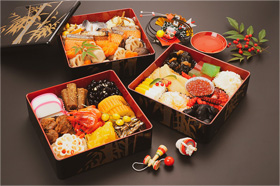 © Web Japan 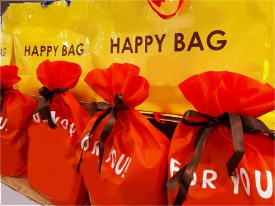 © photoAC 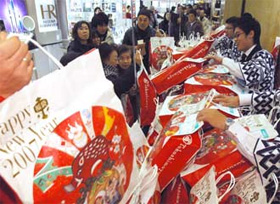 © Jiji 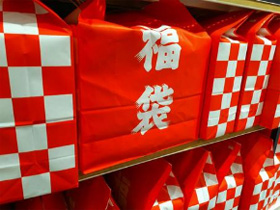 © photoAC |
|
With the random selection of items in each bag, buyers may not get an item they want, or the size they need. Unlucky buyers may even get a bag full of items that they do not want, or are unable to use. It is therefore not unusual to see buyers swapping items with each other outside stores. With the help of social media, buyers can now exchange their items with other users across the country! Some may even sell off part of or their entire haul if their lucky bags are not to their liking.
In recent years, some retailers have also started offering lucky bags that contain “experiences” or “dreams.” These bags are known as yumebukuro, or “dream bags.” In 2007, the Mitsukoshi department store in Tokyo’s Nihonbashi district offered one lucky New Year’s shopper a ‘dream vacation’ -- a luxury trip around the world for two, all for 20.07 million yen (to match the year). Other department stores have also offered a limited number of dream bags that contained travel plans to domestic and international destinations for as low as 2,000 yen. Besides travel plans, some retailers also offer various types of experiences such as recording sessions with renowned musicians, to sports lessons with professional players and coaches. However, with the ongoing global pandemic, many shoppers may be hesitant to mingle in large crowds for a lucky bag. Lucky bags are usually only sold on the first three days of the New Year, but many retailers have extended the sales period to reduce queues and to ensure thinner crowds at their stores. Some retailers have also opened pre-orders online, giving shoppers a chance to shop safely from their homes. The contents of lucky bags have also changed to fit the changing demands of the market. With more people staying home, retailers are including a wider selection of home goods and loungewear in their lucky bags. |
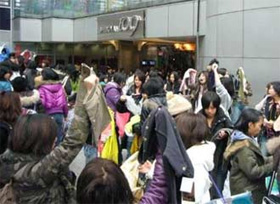 © Shibuya Keizai Shimbun 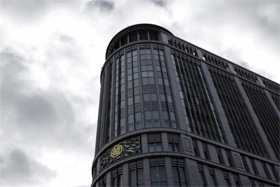 © pakutaso 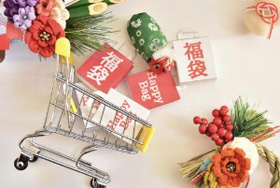 © photoAC |
| This lucky bag tradition is also practiced by some Japanese brands in Singapore! It may not seem like an exciting tradition to Singaporeans, who enjoy a wide range of sales on various platforms all year round, but if you see a retailer you happen to like offering a lucky bag for the New Year, why not give it a shot? You may just get lucky! |
Resources
|
Can you buy luck?! Fukubukuro or lucky bags, a New Year’s specialty. (2014). Retrieved 12 December 2020, from https://japan-magazine.jnto.go.jp/en/1411_luckybag.html |
|
Japan Creative Centre 4 Nassim Road, Singapore 258372 +65 6737 0434 / jcc@sn.mofa.go.jp https://www.sg.emb-japan.go.jp/JCC/ Nearest parking at Orchard Hotel & Delphi Orchard |
 |